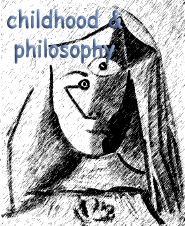the paradox of philosophy for children and how to resolve it
DOI:
https://doi.org/10.12957/childphilo.2020.46431Keywords:
philosophy for children (p4c), student-centred learning, critical thinking, imagination, sir methodAbstract
There is a paradox in the idea of philosophy for children (P4C). Good teaching starts from the concrete and particular, and it engages with each student’s individual interests, beliefs, and experiences. Preadolescents (and to some extent everyone) find this approach more natural than a more impersonal one and respond better to it. But doing philosophy involves focusing on the abstract and general and disengaging oneself from one’s personal interests and beliefs. It involves critiquing one’s attitudes, seeing abstract relations, and applying general principles. So, if good teaching focuses on the concrete and personal, and good philosophy on the abstract and impersonal, how can there be good teaching of philosophy to children? I call this the paradox of philosophy for children, and in this paper I explore how teachers should respond to it. Should they sacrifice good teaching practice, adopting a heavily teacher-centred approach in order to correct their students’ natural biases? Should they lower their expectations of what philosophical skills children can acquire? Should they even attempt to teach philosophy to children? The paper will argue that there is a better option, which exploits children’s imaginative abilities. The core idea is that by encouraging children to imaginatively identify with other perspectives, we can use their natural focus on the concrete and particular to lever them into more abstract, critical ways of thinking. In this way, their focus on the concrete and personal can be the very means to get them to think abstractly and critically. The paper will go on to outline a general strategy for implementing this approach, the Scenario-Identification-Reflection (SIR) method, which will be illustrated with examples drawn from the author’s own classroom practice. The paper will also respond to some objections to the proposed strategy and offer some general reflections on the SIR method.
References
Attard, Angele, Emma Di Iorio, Koen Geven, and Robert Santa. 2010. “Student Centred Learning: Toolkit for Students, Staff and Higher Education Institutions.” Accessed October 25, 2019. https://www.esu-online.org/?publication=student-centred-learning-toolkit-students-staff-higher-education-institutions
Astington, Janet W. 1993. The Child’s Discovery of the Mind. Cambridge, MA: Harvard University Press.
Dietrich, Eric. 2011. “There is no progress in philosophy.” Essays in Philosophy, 12(2): 329-44.
Dickens, Charles. 1854. Hard Times for These Times. London: Bradbury and Evans.
Eliot, George. 1856. “The Natural History of German Life.” Westminster Review, 66: 51-79.
Frankish, Keith. 2018. “What Do You Really Believe? Take the Truth-Demon Test.” Aeon, January 19, 2018. Accessed October 25, 2019. https://aeon.co/ideas/what-do-you-really-believe-take-the-truth-demon-test
Gopnik, Alison. 2009. The Philosophical Baby: What Children’s Minds Tell Us About Truth, Love, and the Meaning of Life. New York: Farrar, Straus and Giroux.
Kahneman, Daniel. 2011. Thinking, Fast and Slow. New York: Farrar, Straus and Giroux.
Mercier, Hugo and Dan Sperber. 2011. “Why Do Humans Reason? Arguments for an Argumentative Theory.” Behavioral and Brain Sciences, 34(2), 57-74.
Mill, John S. 1873. Autobiography. London: Longmans, Green, Reader, and Dyer.
Piaget, Jean. 1933. “Children’s Philosophies.” In A Handbook of Child Psychology, second edition, edited Carl Murchison, 534-47. Worcester, MA: Clark University Press.
Oswald, Magrit E. and Stefan Grosjean. 2004. “Confirmation Bias.” In Cognitive Illusions: A Handbook on Fallacies and Biases in Thinking, Judgement and Memory, edited by Rüdiger Pohl, 79-96. Hove: Psychology Press.
Pohl, Rüdiger F. ed. 2004. Cognitive Illusions: A Handbook on Fallacies and Biases in Thinking, Judgement and Memory. Hove: Psychology Press.
Sapere. n.d. “P4C Research.”. Accessed October 25, 2019. https://www.sapere.org.uk/about-us/p4c-research.aspx.
Schola Europaea. n.d. “Syllabuses.” Accessed October 25, 2019. https://www.eursc.eu/Syllabuses/Forms/Syllabuses.aspx.
Vygotsky, Lev. 1986. Thought and Language. Cambridge, MA: MIT Press.
Wood, David, Jerome S. Bruner, and Gail Ross, G. 1976. The Role of Tutoring in Problem Solving. Journal of Child Psychology and Psychiatry, 17: 89-100.




